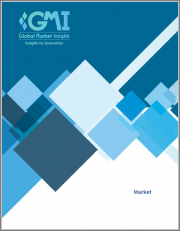
|
시장보고서
상품코드
1354330
서모스탯 시장 규모 : 제품별, 유통 채널별, 작동 모드별, 용도별 및 예측(2023-2032년)Thermostat Market Size By Product, By Distribution Channel, By Mode of Operation, Application & Forecast, 2023 - 2032 |
||||||
세계 서모스탯 시장은 2023년부터 2032년까지 12.8%의 CAGR을 기록할 것으로 예상됩니다.
에너지 효율과 기후변화에 대한 인식과 관심이 높아짐에 따라 소비자와 기업 모두 보다 효율적인 냉난방 방법을 모색하고 있습니다. 이에 따라 온도 설정을 최적화하고 에너지 소비를 줄일 수 있는 스마트 서모스탯에 대한 수요가 증가하고 있습니다.
또한, 에너지 절약을 촉진하기 위한 정부의 규제와 인센티브는 서모스탯 시장을 더욱 촉진하고 있습니다. 뉴욕주는 대규모 에너지 사용자들이 부하를 전기화하고 배출량을 줄이도록 장려하기 위해 1,000만 달러 상당의 상업용 및 산업용 가속 효율화 프로그램을 도입했습니다. 이러한 정책은 에너지 효율이 높은 냉난방 솔루션의 채택을 장려하고 사용자의 에너지 비용을 절감하는 데 도움이 되는 프로그래밍 가능한 스마트 서모스탯에 대한 수요를 증가시키고 있습니다.
서모스탯 시장은 제품, 유통 채널, 작동 모드, 용도 및 지역별로 분류됩니다.
기계식 서모스탯은 저렴한 가격과 신뢰성으로 인해 2023-2032년 7.1% 이상의 CAGR을 기록할 것으로 예상됩니다. 스마트 서모스탯과 프로그래밍 가능한 서모스탯이 인기를 얻고 있지만, 기계식 서모스탯은 예산이 한정된 소비자에게 비용 효율적인 선택으로 남아 있습니다. 특히 첨단 기술 도입이 제한되어 있는 지역에서는 단순함과 내구성이 매력적입니다. 또한, 일부 사용자는 간단한 조작과 연결 기능의 부족을 선호하며, 이는 시장에서 기계식 서모스탯에 대한 지속적인 수요로 이어지고 있습니다.
작동 모드에 따라 저전압 부문은 최신 HVAC 시스템과의 호환성이 향상되어 2032년까지 12.3% 이상의 CAGR을 기록할 것으로 예상됩니다. 저전압 서모스탯은 최신 냉난방 시스템에서 흔히 볼 수 있는 24볼트 전원을 사용하는 경우가 많습니다. 이러한 호환성을 통해 기존 인프라와 원활하게 통합할 수 있기 때문에 HVAC 시스템을 업그레이드하려는 주택 소유자에게 매력적인 선택이 될 수 있습니다. 또한, 저전압 서모스탯은 에너지 효율이 높은 것으로 알려져 있어 지속가능한 솔루션을 원하는 환경 친화적인 소비자에게 매력적인 제품입니다.
주거용 애플리케이션 분야는 주택 개조 및 스마트홈 통합 추세의 증가로 인해 2023-2032년 연평균 13.1% 이상의 CAGR을 기록할 것으로 예상됩니다. 주거 공간 업그레이드에 투자하는 주택 소유자가 늘어남에 따라 최신 에너지 효율이 높은 서모스탯을 설치하는 것이 일반적인 선택이 될 것입니다. 또한, 주거 환경의 편안함과 편의성에 대한 관심이 높아지면서 구역 설정, 음성 제어, 학습 기능과 같은 고급 기능을 제공하는 서모스탯에 대한 관심이 높아져 이 분야의 수요를 더욱 촉진하고 있습니다.
북미 서모스탯 시장은 2032년까지 12.0% 이상의 CAGR을 기록할 것으로 예상됩니다. 혹독한 겨울과 더운 여름에는 효율적인 냉난방 시스템이 필요하기 때문에 주택 소유주들은 에너지 비용을 관리하면서 쾌적함을 유지하기 위해 고급 서모스탯에 투자하고 있습니다. 또한, 북미 지역에서는 정부의 노력과 전력회사 리베이트가 에너지 효율이 높은 솔루션의 도입을 장려하고 있으며, 이는 이 지역의 서모스탯 수요를 더욱 촉진하고 있습니다.
목차
제1장 조사 방법과 조사 범위
제2장 주요 요약
제3장 서모스탯 업계 인사이트
- 생태계 분석
- 벤더 매트릭스
- 규제 상황
- 업계에 대한 영향요인
- 성장 촉진요인
- 업계의 잠재적 리스크와 과제
- 성장 가능성 분석
- Porters 분석
- PESTEL 분석
- 업계 전망에 대한 COVID-19의 영향
제4장 경쟁 벤치마킹
- 혁신과 지속가능성 상황
- 경쟁 상황, 2022년
- 전략 대시보드
제5장 서모스탯 시장 : 제품별
- 주요 동향
- 스마트 서모스탯
- 기계식 서모스탯
- 프로그래머블 서모스탯
- 기타
제6장 서모스탯 시장 : 유통 채널별
- 주요 동향
- 유틸리티
- 소매
- 보안
- 공조
제7장 서모스탯 시장 : 동작 모드별
- 주요 동향
- 저전압
- 라인 전압
- 밀리 볼트
제8장 서모스탯 시장 : 용도별
- 주요 동향
- 주택
- 상업시설
- 교육기관
- 오피스 빌딩
- 소매
- 병원
- 기타
- 산업
제9장 서모스탯 시장 : 지역별
- 주요 동향
- 북미
- 미국
- 캐나다
- 멕시코
- 유럽
- 영국
- 프랑스
- 독일
- 이탈리아
- 스웨덴
- 덴마크
- 스페인
- 러시아
- 아시아태평양
- 중국
- 일본
- 한국
- 인도
- 호주
- 말레이시아
- 인도네시아
- 중동 및 아프리카
- UAE
- 사우디아라비아
- 카타르
- 오만
- 쿠웨이트
- 이집트
- 남아프리카공화국
- 라틴아메리카
- 브라질
- 아르헨티나
- 칠레
- 페루
제10장 기업 개요
- Trane
- Legrand
- Schneider Electric
- Nortek Global HVAC
- Radio Thermostat Company of America
- COMPUTIME LIMITED
- Johnson Controls
- Danfoss
- Carrier Corporation
- Emerson Electric Co.
- Sensata Technologies, Inc.
- Trafag
- Venstar Inc.
- tado GmbH
- Lennox International Inc.
- Ecobee
Global Thermostat Market will witness a 12.8% CAGR between 2023-2032. the increasing awareness and concern about energy efficiency and climate change have led consumers and businesses alike to seek more efficient ways of heating and cooling their spaces. This has resulted in a growing demand for smart thermostats that can optimize temperature settings and reduce energy consumption.
Additionally, government regulations and incentives aimed at promoting energy conservation have further propelled the thermostat market. New York introduced a Commercial and Industrial Accelerated Efficiency Program worth USD 10 million to incentivize large energy users to electrify loads and mitigate emissions. These policies encourage the adoption of energy-efficient heating and cooling solutions, boosting the demand for programmable and smart thermostats that can help users save on energy bills.
The thermostat market is categorized based on product, distribution channel, mode of operation, application, and region.
The mechanical thermostat will record over 7.1% CAGR between 2023-2032, due to their affordability and reliability. While smart and programmable thermostats have gained popularity, mechanical thermostats remain a cost-effective choice for consumers on a budget. Their simplicity and durability make them appealing, particularly in regions where advanced technology adoption may be limited. Moreover, some users prefer the straightforward operation and lack of connectivity features, leading to sustained demand for mechanical thermostats in the market.
Based on mode of operation, the low voltage segment will exhibit over 12.3% CAGR through 2032, as they offer enhanced compatibility with modern HVAC systems. These thermostats often use a 24-volt power source, which is common in newer heating and cooling systems. This compatibility makes them an attractive choice for homeowners upgrading their HVAC systems, as they can seamlessly integrate with existing infrastructure. Additionally, low-voltage thermostats are known for their energy efficiency, making them appealing to environmentally conscious consumers seeking sustainable solutions.
The residential application segment will depict more than 13.1% CAGR over 2023-2032, due to the rising trend of home renovation and smart home integration. As more homeowners invest in upgrading their living spaces, the installation of modern, energy-efficient thermostats becomes a common choice. Moreover, the growing emphasis on comfort and convenience in residential settings has led to increased interest in thermostats that offer advanced features like zoning, voice control, and learning capabilities, further driving the demand in this sector.
North America thermostat market will record over 12.0% CAGR through 2032, driven by the extreme weather conditions experienced in many regions. Harsh winters and hot summers necessitate efficient heating and cooling systems, prompting homeowners to invest in advanced thermostats to maintain comfort while managing energy costs. Additionally, government initiatives and utility rebates in North America encourage the adoption of energy-efficient solutions, further fueling the demand for thermostats in the region.
Table of Contents
Chapter 1 Methodology & Scope
- 1.1 Market scope and definitions
- 1.2 Base estimates & calculations
- 1.3 Forecast calculations
- 1.4 Data sources
- 1.4.1 Primary
- 1.4.2 Secondary
- 1.4.2.1 Paid sources
- 1.4.2.2 Public sources
Chapter 2 Executive Summary
- 2.1 Thermostat industry 360 degree synopsis, 2019 - 2032
- 2.1.1 Business trends
- 2.1.2 Product trends
- 2.1.3 Distribution channel trends
- 2.1.4 Mode of operation trends
- 2.1.5 Application trends
- 2.1.6 Regional trends
Chapter 3 Thermostat Industry Insights
- 3.1 Industry ecosystem analysis
- 3.1.1 Vendor matrix
- 3.2 Regulatory landscape
- 3.3 Industry impact forces
- 3.3.1 Growth drivers
- 3.3.2 Industry pitfalls & challenges
- 3.4 Growth potential analysis
- 3.5 Porter's Analysis
- 3.5.1 Bargaining power of suppliers
- 3.5.2 Bargaining power of buyers
- 3.5.3 Threat of new entrants
- 3.5.4 Threat of substitutes
- 3.6 PESTEL Analysis
- 3.7 COVID- 19 impact on the industry outlook
Chapter 4 Competitive Benchmarking
- 4.1 Innovation & sustainability landscape
- 4.2 Competitive landscape, 2022
- 4.2.1 Strategy dashboard
Chapter 5 Thermostat Market, By Product
- 5.1 Key product trends
- 5.2 Smart thermostat
- 5.3 Mechanical thermostat
- 5.4 Programmable thermostat
- 5.5 Others
Chapter 6 Thermostat Market, By Distribution Channel
- 6.1 Key distribution channel trends
- 6.2 Utility
- 6.3 Retail
- 6.4 Security
- 6.5 HVAC
Chapter 7 Thermostat Market, By Mode of Operation
- 7.1 Key mode of operation trends
- 7.2 Low voltage
- 7.3 Line voltage
- 7.4 Millivolt
Chapter 8 Thermostat Market, By Application
- 8.1 Key application trends
- 8.2 Residential
- 8.3 Commercial
- 8.3.1 Educational institutes
- 8.3.2 Office buildings
- 8.3.3 Retail
- 8.3.4 Hospitals
- 8.3.5 Others
- 8.4 Industrial
Chapter 9 Thermostat Market, By Region
- 9.1 Key regional trends
- 9.2 North America
- 9.2.1 U.S.
- 9.2.2 Canada
- 9.2.3 Mexico
- 9.3 Europe
- 9.3.1 UK
- 9.3.2 France
- 9.3.3 Germany
- 9.3.4 Italy
- 9.3.5 Sweden
- 9.3.6 Denmark
- 9.3.7 Spain
- 9.3.8 Russia
- 9.4 Asia Pacific
- 9.4.1 China
- 9.4.2 Japan
- 9.4.3 South Korea
- 9.4.4 India
- 9.4.5 Australia
- 9.4.6 Malaysia
- 9.4.7 Indonesia
- 9.5 Middle East & Africa
- 9.5.1 UAE
- 9.5.2 Saudi Arabia
- 9.5.3 Qatar
- 9.5.4 Oman
- 9.5.5 Kuwait
- 9.5.6 Egypt
- 9.5.7 South Africa
- 9.6 Latin America
- 9.6.1 Brazil
- 9.6.2 Argentina
- 9.6.3 Chile
- 9.6.4 Peru
Chapter 10 Company Profiles
- 10.1 Trane
- 10.2 Legrand
- 10.3 Schneider Electric
- 10.4 Nortek Global HVAC
- 10.5 Radio Thermostat Company of America
- 10.6 COMPUTIME LIMITED
- 10.7 Johnson Controls
- 10.8 Danfoss
- 10.9 Carrier Corporation
- 10.10 Emerson Electric Co.
- 10.11 Sensata Technologies, Inc.
- 10.12 Trafag
- 10.13 Venstar Inc.
- 10.14 tado GmbH
- 10.15 Lennox International Inc.
- 10.16 Ecobee



















